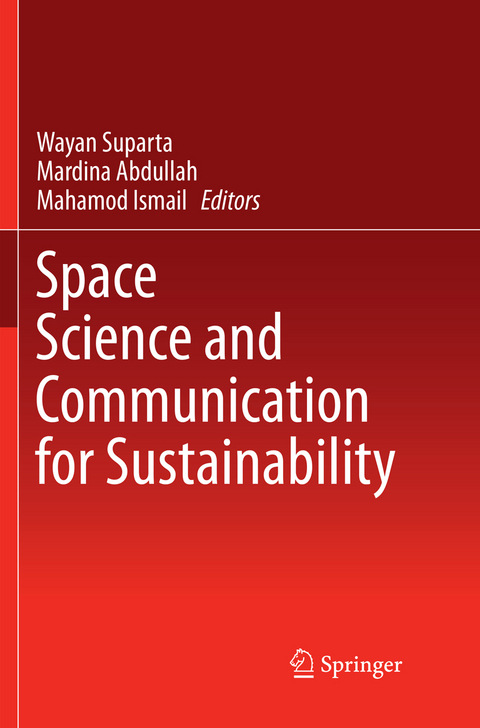
Space Science and Communication for Sustainability
Springer Verlag, Singapore
978-981-13-4905-8 (ISBN)
This book was prepared in conjunction with the fifth meeting of the 2017 International Conference on Space Science and Communication (IconSpace2017), held in Kuala Lumpur, Malaysia on 3-5 May 2017 to introduce graduate stuandents, researchers, lecturers, engineers, geospatialists, meteorologists, climatologists, astronomers and practitioners to the latest applications of space science, telecommunications, meteorology, remote sensing and related fields. The individual papers discuss a broad range of space science and technology applications, e.g. the formation of global warming from space, environmental and remote sensing, communication systems, and smart materials for space applications.
Wayan Suparta received his PhD in Electrical, Electronic and Systems Engineering from the Faculty of Engineering, Universiti Kebangsaan Malaysia (UKM). He was appointed as a senior lecturer (July 2008 - March 2012) and an associate professor (April 2012 - March 2017) at the Space Science Centre (ANGKASA), Institute of Climate Change, UKM. He is currently working as an SciTech and Education Consultant at the private company. His research interests involve Space Meteorology, Artificial Neural Network Applications and Communications (Remote Sensing). He has had frequent collaborations with academic centers such as the National Institute of Polar Research (NIPR) Japan, Science Institute of University of Iceland, the University of Canterbury New Zealand, and the Instituto Antártico Argentino (IAA). The results of his scientific research have been published in over 100 articles, four book chapters, and three books. Mardina Abdullah is a Professor at the Department of Electrical, Electronics and Systems Engineering, Faculty of Engineering and Built Environment, Universiti Kebangsaan Malaysia (UKM). She is the Head of the Space Science Centre (ANGKASA), Institute of Climate Change, Universiti Kebangsaan Malaysia (UKM). Her primary research interests are in ionospheric research & navigation satellites (global positioning system, GPS) and industrial engineering. Mahamod Ismail joined the Department of Electrical, Electronics and Systems Engineering, Faculty of Engineering and Built Environment, Universiti Kebangsaan Malaysia (UKM) in 1985. He is the former Head of the Department and a Professor of Communication Engineering. He received his BSc in Electrical and Electronics from the University of Strathclyde, UK in 1985, his MSc in Communication Engineering and Digital Electronics from the University of Manchester Institute of Science and Technology (UMIST), Manchester,UK in 1987, and his PhD from the University of Bradford, UK in 1996. He was with the first Malaysia Microsatellite TiungSat Team Engineers in Surrey Satellite Technology Ltd. UK from June 1997 until March 1998. In the summer semester 2003, he served as a Guest Professor of Computer Engineering at the University of Duisburg-Essen, Duisburg, Germany funded by the German Academic Exchange Services (DAAD). His research interests include mobile and satellite communication and wireless networking, especially radio resource management for next-generation wireless communication networks. He is a Senior Member of the Institute of Electrical and Electronics Engineers (SMIEEE), USA and served as Chair of the IEEE’s Malaysia Section from 2011 to 2012.
Characterization of Lightning Energy During 2014-2015 Summer and Winter Over the Antarctic Peninsula.- Parametric Studies of ANFIS Families Capability for Thunderstorm Prediction.- Performance and Evaluation of Eight Cloud Models on Earth-Space Path for a Tropical Station.- Comparison of Insitu Observation, NOAA-AIRS Satellite and MACC Model on Surface Ozone Over Ushuaia, Southern Ocean and Antarc-tic Peninsula Region.- A Brief Review: Response of the Lonosphere to Solar Activity Over Malaysia.- Time Derivative of Horizontal Geomagnetic Field of Low Latitude MAGDAS LANGKAWI Station for Geomagnetically Induced Cur-rent Estimation.
| Erscheinungsdatum | 19.12.2018 |
|---|---|
| Zusatzinfo | 181 Illustrations, color; 42 Illustrations, black and white; IX, 348 p. 223 illus., 181 illus. in color. |
| Verlagsort | Singapore |
| Sprache | englisch |
| Maße | 155 x 235 mm |
| Themenwelt | Naturwissenschaften ► Biologie ► Ökologie / Naturschutz |
| Naturwissenschaften ► Physik / Astronomie ► Angewandte Physik | |
| Naturwissenschaften ► Physik / Astronomie ► Astronomie / Astrophysik | |
| Technik ► Elektrotechnik / Energietechnik | |
| Technik ► Luft- / Raumfahrttechnik | |
| Technik ► Nachrichtentechnik | |
| Schlagworte | Environmental Pollution • Global Positioning Systems (GPS) • Magnetospheric Sciences • Remote Sensing • Satellite Communication Technology • Satellite navigation • Space Technology • Wireless Communication Network |
| ISBN-10 | 981-13-4905-3 / 9811349053 |
| ISBN-13 | 978-981-13-4905-8 / 9789811349058 |
| Zustand | Neuware |
| Haben Sie eine Frage zum Produkt? |
aus dem Bereich


